I owe Jane Byrne for launching my journalism career
I owe Jane Byrne for launching my journalism career 5.00/5 (100.00%) 2 votes
Chicago Mayor Jane M. Byrne, who died on Thursday Nov. 13, 2014, was Chicago’s first female elected chief executive and the 41st mayor of the City of Chicago. The turbulence of her politics and administration launched my journalism career, and for that I owe her much
Jane Byrne defeated the Machine but she became the Machine and the Machine was defeated again, when she was at the helm, in 1983 by Harold Washington. And it was defeated again in 1989 when the Machine took over and appointed Eugene Sawyer as Mayor, and Rich Daley, then the despised outsider, took it back. The Chicago Machine was never gone and Jane Byrne’s story is the story of the Chicago Machine.
By Ray Hanania
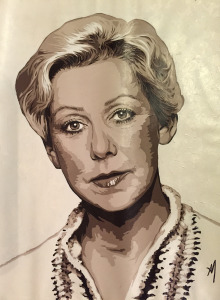
Jane Byrne portrait commissioned by Byrne aide Frank Santoro. Copyright 2014 Ray Hanania. All rights reserved. Permission to republish with full credit to Ray Hanania and Illinois News Network www.IllinoisNewsNetwork.com
Jane Byrne launched my journalism career.
I had just entered journalism in 1975, months after being honorably discharged for my service during the Vietnam War in the U.S. Air Force. I was motivated by my concerns for biased news reporting of the Middle East by the mainstream news media at that time and had launched a small Chicago newspaper called The Middle Eastern Voice.
During my military service, which included the Arab-Israeli war of 1973, the Arabs had been so poorly and wrongly portrayed by the news media, I was driven to want to change those inaccurate perceptions, giving up a career to become a doctor and instead pursued writing.
My first effort to get hired was at the Southwest Messenger Press where publisher Walter Lysen hired me to write features about the Southwest Suburbs of Chicagoland. My first columns addressed issues that ranged from the theft of newspaper bundles left by homeowners with their garbage to help the poor and needy, taken by “gypsy rummagers,” at the time, and stories of cases that came before the Cook County courts.
I was also writing letters to local and national publications like Time and Newsweek, challenging their biased and one-sided reporting on the Arab World, the Middle East and American Arabs. And I wrote letters challenging anti-Arab bias in the local media including at the twice-weekly community newspaper The Southtown Economist.
The editor Marlin Landwher and Publisher Bruce Sagan at the Southtown called me one day in 1977 and hired me as a freelancer and later gave me a fulltime position for $150 a week in January 1978 as an education and political reporter. In March of 1978, just after my first child Carolyn was born, the newspaper went daily (to exploit the closing of the Chicago Daily News) and I began to focus on political writing.
That summer Sagan asked if anyone wanted to cover Chicago City Hall. None of the “professionally” trained journalists wanted to go as it required a lot of hardwork to drive there, hangout, write your stories and bring it back. Most preferred hanging around the newsroom and going to lunch together at the local beef and sausage stand a block away where they hung out and traded “journalism” stories. City Hall was considered a “dead beat.” Nothing was happening there since Mayor Richard J. Daley had died just before Christmas in 1976.
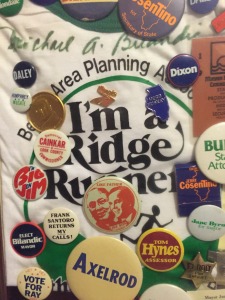
Bilandic autographed souvenir from the 1978 Ridge Run. Copyright 2014 Ray Hanania. All rights reserved. Permission to republish with full credit to Ray Hanania and Illinois News Network www.IllinoisNewsNetwork.com
But I enthusiastically raised my hand, the only taker, and began covering the boring and uneventful administration of then Mayor Michael A. Bilandic, Daley’s successor.
One of my first stories was to run with Mayor Bilandic in the Beverly Marathon, organized by the Beverly Area Planning Association (BAPA). The column I wrote about the experience, my first 10 K Marathon, was entitled, “Five Hail Marys and a Pair of Adidas.” It was about the struggle I went through to keep up with Bilandic who wasn’t much of an administrator but was a great runner and jogger. When it was over, Bilandic autographed for me the souvenir shirt that was made to commemorate the marathon, which I still have.
And that’s when Jane Byrne popped up. She wasn’t a name I had heard much, but she had been Daley’s Commissioner of Consumer Services, Weights and Measures who had been fired by Bilandic when she started to ask questions about how his administration had approved taxi cab fare increases. Byrne charged Bilandic and his aides, an “Evil Cabal of Men” had “greased” those increases.
In her press release, Byrne referred to Bilandic’s floor leaders, Aldermen Ed Vrdolyak, Ed Burke and the mob representative Alderman Fred Roti as the “Evil Cabal of Men,” and later interchangeably as the “Cabal of Evil Men.” It was great public relations spin created by her husband, former City Hall reporter Jay McMullen, one of the most colorful and fascinating journalists of the time. He was truly a remnant to the old Front Page Journalism Era of Chicago.
I ended up moving to City Hall fulltime and Celeste Jurkovich, Bilandic’s press secretary, assigned a desk and telephone that I could use located in the northwest corner of the press room on the 2nd floor overlooking LaSalle Street and the Bismarck Hotel across it. That’s when I got to know Harry Golden Jr., the City Hall reporter for the Chicago Sun-Times, who later became my mentor and urged Editor Ken Towers to hire me as a political writer to help him at City Hall and the new Page Ten Column that was launched in March 1985. (Click here to read my memoirs of working in the City Hall press room during the Jane Byrne years, that first ran in the Chicago Reader.)
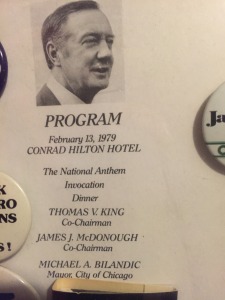
Bilandic program at the Chicago Chamber of Commerce, 1979. Copyright 2014 Ray Hanania. All rights reserved. Permission to republish with full credit to Ray Hanania and Illinois News Network www.IllinoisNewsNetwork.com
At first, Byrne was an anomaly. Although I was based at City Hall, I found myself driving back out to the Southwest Side and suburbs to cover Byrne, who would make occasional forays into City Hall to stir up trouble and make accusations about Bilandic. No one took her that seriously at first but I did cover her entire campaign. Byrne spent much time focusing her efforts on speaking to the core of the Chicago Machine Vote that Bilandic controlled, White policemen, firemen and city workers who huddled in warrens against the city’s Southwest and Northwest side borders, crammed in there as a result of the White Flight that had taken place from other parts of the city to escape the growing African American population. (Click here to read my online story about that experience of White Flight called Midnight Flight: One Family’s Experience of White Flight and the racial transformation of Chicago’s South Side.)
I would follow Byrne to Burbank, one of the only places where she was allowed to hold campaign meetings because the aldermen leaned on local Chicago hall owners not to allow her to hold events there. Bilandic’s top Council advisers were brutal and would punish anyone who let Byrne find a platform to speak to voters. One time, she met with the so-called “Bogan Broads” who I knew from covering their anti-integration protests at Bogan High school (where I had attended, by the way, for a few months before being expelled because I was too dark for the school). The group met at Caesar’s Inn in Burbank just west of Cicero Avenue, the Chicago Border of the 18th Ward, on 79th Street. Byrne was a fiery speaker. One tough candidate. She was ready for the fight and later, after she won the election, was nicknamed “Fighting Jane” by two of her supporters who wrote a book by that name, Bill and Lori Granger. They were great writers and were the first to document Byrne’s rise to the top of Machine Politics.
Honestly, if Chicago had been Phoenix or even Los Angeles, which was fighting us for the title “Second City,” Byrne would have become just a footnote in Chicago political history. But she lived in Chicago where the fiercest of winters would rile up the population every few years. And this Winter was to be one of those years.
It started in January with a blizzard that rocked the city’s transportation. Bilandic was a great mathematician and former chairman of the City Council Finance Committee, but he was no administrator of the nation’s second largest city. He wasn’t very good. He was surrounded by incompetents whose excessive resulted in stories of corruption and greed and political shenanigans.
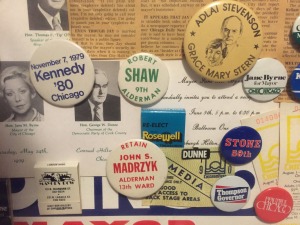
Copyright 2014 Ray Hanania. All rights reserved. Permission to republish with full credit to Ray Hanania and Illinois News Network www.IllinoisNewsNetwork.com
The snowstorm that slammed Chicago that Winter and continued through 1979 set the stage for one of the biggest political upsets in Chicago politics history.
The truth is that Jane Byrne was never really a “reformer” or an “outsider.” That’s how she was forced to run. She ran to exact vengeance against Bilandic and the Cabal for punishing her, and the Cabal was brutal and vicious towards Jane Byrne and McMullen.
Jane Byrne did defeat the Chicago Machine but within six months, Byrne became the head of the Chicago Machine when she dumped the three aldermen who led her brief dalliance with “reform” and turned to the very Cabal she blasted — a scoop I first broke — to run her council administration, Vrdolyak, Burke and Roti.
Byrne was disgusted with the incompetence of the leaders of her new floor leaders, led by Machine Alderman Bill Lipinski and longtime liberal voice Ald. Marty Oberman. They were joined by Ald. John Aiello. But the trio continued to stumble through council meetings and embarrassed Byrne so many times, she had had enough. The breaking point came during the City Council investigation of the police handling of the Serbian terrorist hijacking at O’Hare Airport in the summer of 1979. Vrdolyak’s brother, Victor, was the police commander in charge. Although Vrdolayk thought nothing of punishing anyone associated with Byrne when she was the fired former Consumer Sales Commissioner, he whined about how his brother had been abused and mistreated by Byrne. But he correctly pointed out that the truth is nothing had really changed. What Byrne did to demote and blame his brother Victor was “Politics, Chicago Style” and nothing more.
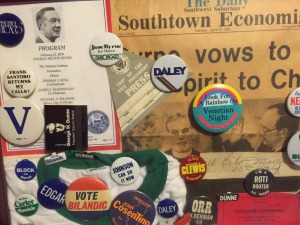
Copyright 2014 Ray Hanania. All rights reserved. Permission to republish with full credit to Ray Hanania and Illinois News Network www.IllinoisNewsNetwork.com
Within weeks, that August 1979, Vrdolyak and First Ward Committeeman John D’Arco Sr., were now running the City Council and Lipinski, Oberman and Aiello were out to hang with the sniffling and whining Richie Daley,t he son of the late Mayor who wanted to badly to take his father’s place but didn’t have the skills to do it.
It was a personal issue that fuel my rise in the news media. And it happened several weeks after Byrne had turned over her “reform” administration to the Evil Cabal of Men she scorned for election purposes.
McMullen had lost his job when the Daily News closed, and was promised a job with Cook County Clerk Morgan Finley, but when Bilandic learned that Finley was going to hire McMullen, Finley reneged on the deal. Later, when Byrne became mayor, one of her first acts was to find someone to run against Finley, as revenge, a story I published that provoked McMullen to call me in the City Hall Press Room when Byrne was mayor and threaten to punch me in the nose. That threat became one of the first big stories about Byrne’s mercurial new woman mayor, who we learned to address as “Madam Mayor.”
That threat jettisoned me in the news media stratosphere and put me in the center of the Jane Byrne storm. Byrne was enjoying a “honeymoon” with the news media although the cracks started to burst internally among reporters.
Byrne didn’t like criticism but worse, McMullen didn’t like the idea that I had written in my now twice weekly political column, The Political Grapevine, that he needed a “woman” to defend his reputation. That’s what provoked his phone call to the City Hall press room and I waved to the other reporters, Golden and the Tribune’s Bob Davis to get on the extension lines and listen in as McMullen raged about how he was going to punch me in the nose and beat the crap outta of me if I ever wrote another column suggesting he needed any woman to defend his reputation.
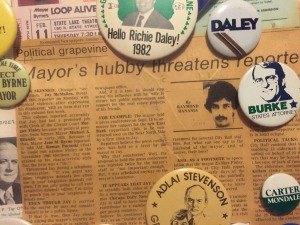
Hanania column on McMullen threatening to punch Hanania in the nose. Copyright 2014 Ray Hanania. All rights reserved. Permission to republish with full credit to Ray Hanania and Illinois News Network www.IllinoisNewsNetwork.com
It was a first and I was thinking of it as a news story at first. Just one of those unbelievable incidents that were slowly building up in the Byrne administration. “You have to hear this guys.”
McMullen was yelling and screaming at me over the phone and I just started scribbling notes and so did the other reporters. Before you knew it, the incident became a major story in both downtown newspapers, and in my column that Sunday in the Daily Southtown. Jane Byrne screamed at me, too, and began pointing fingers at me at press conferences, like when there were rumors that the White Sox were going to leave Chicago (or maybe the Cubs), Byrne refused to comment and suggested that all the reporters talk to me, since they had all listened in on McMullen’s telephone threats to beat me up the day before. “Just talk to him,” Byrne snapped.
And the media avalanche just couldn’t be stopped. Every TV station wanted to interview me. The biggest and best at the time was Walter Jacobson who was doing commentaries. Jacobson called it a “snit,” and Byrne couldn’t stop “snitting,” especially against me.
Every time I would write something in my column, Byrne would address me at her press conferences, including claiming that the reason I was attacking her was that I had given her my resume, after her election (which I did do) to get a job. She said I wanted to replace her press secretary Mike Sneed, who was always hostile to me in her Tribune gossip column. Harry Golden Jr., once declared in the City Hall Press Room that he used her column “as a guide on what not to report.” City Hall could be brutal to everyone. Sneed was an accomplished and talented writer, and her column became one of the cornerstones of insider political tales and regale.
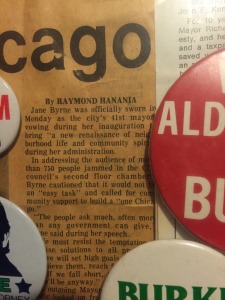
Copyright 2014 Ray Hanania. All rights reserved. Permission to republish with full credit to Ray Hanania and Illinois News Network www.IllinoisNewsNetwork.com
Producer Tom Webb at WLUP FM Radio reached out to me and offered me a radio show, which I took. And eventually, I moved to host live shows on WLS Radio on Saturday and Sundays that focused on Chicagoland politics. It wasn’t long that I was hired by the Chicago Sun-Times to write politics for Page Ten and later to return to City Hall where I worked until 1992 when I battled the Sun-Times over writing features on Palestine as the nation’s only Palestinian American Journalist and the editors used Miriam Santos as the excuse to finally get rid of my “Arab journalism activism.”
I will say Jane Byrne was very respectful of my Arab heritage. It was a few aldermen who called me “sandnigger” to my face, but that was not something that a newspaper would report back then. When my mother passed away in 1986, Byrne as a former mayor, visited the Wake to pay her respects, noting she met my mother during her term as Chicago Mayor at the Navy Pier Ethnic Folk Festival which included an Arab Heritage Display my mother helped organize with other American Arab activists like Fadwa Hassan, Ghada Talhami and the late Mimi Khateeb.
Eventually the story shifted away from me to everyone. The reporters created a term called “gangbangs” to describe how we covered Jane Byrne. It wasn’t because she was a woman, but as inappropriate as it was, it described the battle that ensued when Byrne and the media would confront each other, especially when she entered and left City Hall at the 5th Floor elevator where reporters hung out waiting for her every whim to spill out in shoot-from-the-hip policy pronouncements.
When I started at City Hall under Bilandic, I wrote about four stories a week. When Byrne became mayor, I wrote five stories every day. I brought the first computer to the City Hall press room, as a apart of a program run by Computer People Magazine where I freelanced as a computer technology writer. I loved computers and those early days were fun. You needed a computer to keep up with Byrnes rapid fire pace of “committing news.”
In the end, Jane Byrne never received the respect she deserved. Although her administration was controversial, Jane Byrne did many great things in Chicago that were sidelined or overshadowed by the controversy with the news media. Byrne is the first mayor to put the focus on neighborhoods, creating the Chicago Neighborhood Department. And, although she was often criticized for this, her move into Cabrini Green

Copyright 2014 Ray Hanania. All rights reserved. Permission to republish with full credit to Ray Hanania and Illinois News Network www.IllinoisNewsNetwork.com
put a national spotlight on the tragic daily lives of the poor and African Americans. Her enthusiasm and love for Chicago created the practice of organizing neighborhood and citywide festivals that create a community and public involvement that helped fight street gangs. It’s a lesson I learned and have never forgotten. If you organize enough public activities and festivals that cause the public to engage and get involved, their involvement as a public and a community help to push away street gangs and crime. Criminals and street gang members don’t like to see people come out of their homes. The street gang thugs want homeowners to hide in their homes and not come outside. But when a neighborhood has a festival that brings neighbors together, those neighbors suddenly find a strength that stands up to the street gan scourge. Her fight against crime was never fully acknowledged.
Byrne deserves more than just the naming of the Water Tower Plaza in her memory. She was a powerful force of change in Chicago and deserves to be remembered a powerful and lasting way. Despite the shallowness of the controversies that haunted her four years in office, she was a good person. She loved Chicago. And what she did was intended to make Chicago great. In the end, she more than anyone made it possible for Chicago to be great.
No one could have followed who did — Not Harold Washington, not Richie Daley and not Rahm Emanuel — had it not been for her efforts in the summer of 1978.
(Footnote. One of the big controversies was what number mayor was Jane Byrne. Jane Byrne was the 41st Mayor of Chicago, counting by individuals who held the position, but was the 50th Mayor counting based on the number of mayoral administrations that held office. Initially, she was touted by her administration and the media as the 42nd Mayor of Chicago, because of a miscount of the number of actual individuals who served as mayor.)
(Ray Hanania is an award winning former Chicago City Hall reporter. He is a political columnist with the Regional News Newspaper, Southwest News-Herald Newspaper and Des Plaines Valley News Newspaper. He also writes on Middle East issues for Creators Syndicate. Reach him at [email protected]. He is the managing editor of Illinois News Network www.IllinoisNewsNetwork.com.)
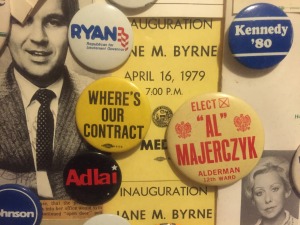
Pass to attend the April 16, 1979 inauguration ceremony for Jane M. Byrne. Copyright 2014 Ray Hanania. All rights reserved. Permission to republish with full credit to Ray Hanania and Illinois News Network www.IllinoisNewsNetwork.com
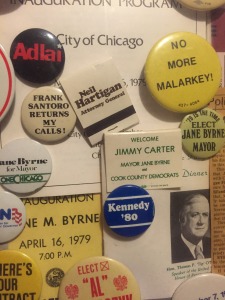
Copyright 2014 Ray Hanania. All rights reserved. Permission to republish with full credit to Ray Hanania and Illinois News Network www.IllinoisNewsNetwork.com
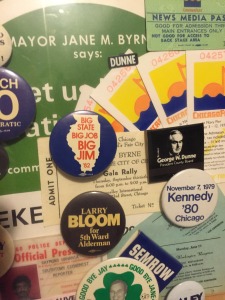
Copyright 2014 Ray Hanania. All rights reserved. Permission to republish with full credit to Ray Hanania and Illinois News Network www.IllinoisNewsNetwork.com

Copyright 2014 Ray Hanania. All rights reserved. Permission to republish with full credit to Ray Hanania and Illinois News Network www.IllinoisNewsNetwork.com

Copyright 2014 Ray Hanania. All rights reserved. Permission to republish with full credit to Ray Hanania and Illinois News Network www.IllinoisNewsNetwork.com

Blogger, Columnist at Illinois News Network Online
Ray Hanania is senior blogger for the Illinois News Network online news site. He is an award winning former Chicago City Hall political reporter and columnist who covered the beat from 1976 through 1992 (From Mayor Daley to Mayor Daley).
In 1976, he was hired by the Chicago community newspaper The Southtown Economist (Daily Southtown) and in 1985 was hired by the Chicago Sun-Times and covered Chicago City Hall for both. In 1993, he launched the “The Villager” Newspapers which covered 12 Southwest Chicagoland suburban regions. He hosted a live weekend Radio Show on WLS AM radio from 1980 through 1991, and also on WBBM FM, WLUP FM and shows on WSBC AM in Chicago and WNZK AM in Detroit.
Hanania is the recipient of four (4) Chicago Headline Club “Peter Lisagor Awards” for Column writing. In November 2006, he was named “Best Ethnic American Columnist” by the New American Media;In 2009, he received the prestigious Sigma Delta Chi Award for Writing from the Society of Professional Journalists. Hanania has also received two (2) Chicago Stick-o-Type awards from the Chicago Newspaper Guild, and in 1990 was nominated by the Chicago Sun-Times for a Pulitzer Prize for his four-part series on the Palestinian Intifada.
Hanania’s writings have been published in newspapers around the world. He currently is syndicated through Creators Syndicate and his column is feature every Sunday in the Saudi Gazette in Saudi Arabia. He has written for the Jerusalem Post, YNetNews.com, Newsday in New York, the Orlando Sentinel, the Houston Chronicle, The Daily Star, the News of the World, the Daily Yomimuri in Tokyo, Chicago Magazine, the Arlington Heights Daily Herald, and Aramco Magazine. His Chicagoland political columns are published in the Southwest News-Herald and Des Plaines Valley News on several Chicagoland blogs including the OrlandParker.com and SuburbanChicagoland.com.
Hanania is the President/CEO of Urban Strategies Group media and public affairs consulting which has clients in Illinois, Florida, Michigan and Washington D.C.
His personal website is www.TheMediaOasis.com. Email him at:
[email protected].
Latest posts by Ray Hanania (see all)
Related
 Blog Posts
Blog Posts






I owe Jane Byrne for launching my journalism career
Chicago Mayor Jane M. Byrne, who died on Thursday Nov. 13, 2014, was Chicago’s first female elected chief executive and the 41st mayor of the City of Chicago. The turbulence of her politics and administration launched my journalism career, and for that I owe her much
Jane Byrne defeated the Machine but she became the Machine and the Machine was defeated again, when she was at the helm, in 1983 by Harold Washington. And it was defeated again in 1989 when the Machine took over and appointed Eugene Sawyer as Mayor, and Rich Daley, then the despised outsider, took it back. The Chicago Machine was never gone and Jane Byrne’s story is the story of the Chicago Machine.
By Ray Hanania
Jane Byrne portrait commissioned by Byrne aide Frank Santoro. Copyright 2014 Ray Hanania. All rights reserved. Permission to republish with full credit to Ray Hanania and Illinois News Network www.IllinoisNewsNetwork.com
Jane Byrne launched my journalism career.
I had just entered journalism in 1975, months after being honorably discharged for my service during the Vietnam War in the U.S. Air Force. I was motivated by my concerns for biased news reporting of the Middle East by the mainstream news media at that time and had launched a small Chicago newspaper called The Middle Eastern Voice.
During my military service, which included the Arab-Israeli war of 1973, the Arabs had been so poorly and wrongly portrayed by the news media, I was driven to want to change those inaccurate perceptions, giving up a career to become a doctor and instead pursued writing.
My first effort to get hired was at the Southwest Messenger Press where publisher Walter Lysen hired me to write features about the Southwest Suburbs of Chicagoland. My first columns addressed issues that ranged from the theft of newspaper bundles left by homeowners with their garbage to help the poor and needy, taken by “gypsy rummagers,” at the time, and stories of cases that came before the Cook County courts.
I was also writing letters to local and national publications like Time and Newsweek, challenging their biased and one-sided reporting on the Arab World, the Middle East and American Arabs. And I wrote letters challenging anti-Arab bias in the local media including at the twice-weekly community newspaper The Southtown Economist.
The editor Marlin Landwher and Publisher Bruce Sagan at the Southtown called me one day in 1977 and hired me as a freelancer and later gave me a fulltime position for $150 a week in January 1978 as an education and political reporter. In March of 1978, just after my first child Carolyn was born, the newspaper went daily (to exploit the closing of the Chicago Daily News) and I began to focus on political writing.
That summer Sagan asked if anyone wanted to cover Chicago City Hall. None of the “professionally” trained journalists wanted to go as it required a lot of hardwork to drive there, hangout, write your stories and bring it back. Most preferred hanging around the newsroom and going to lunch together at the local beef and sausage stand a block away where they hung out and traded “journalism” stories. City Hall was considered a “dead beat.” Nothing was happening there since Mayor Richard J. Daley had died just before Christmas in 1976.
Bilandic autographed souvenir from the 1978 Ridge Run. Copyright 2014 Ray Hanania. All rights reserved. Permission to republish with full credit to Ray Hanania and Illinois News Network www.IllinoisNewsNetwork.com
But I enthusiastically raised my hand, the only taker, and began covering the boring and uneventful administration of then Mayor Michael A. Bilandic, Daley’s successor.
One of my first stories was to run with Mayor Bilandic in the Beverly Marathon, organized by the Beverly Area Planning Association (BAPA). The column I wrote about the experience, my first 10 K Marathon, was entitled, “Five Hail Marys and a Pair of Adidas.” It was about the struggle I went through to keep up with Bilandic who wasn’t much of an administrator but was a great runner and jogger. When it was over, Bilandic autographed for me the souvenir shirt that was made to commemorate the marathon, which I still have.
And that’s when Jane Byrne popped up. She wasn’t a name I had heard much, but she had been Daley’s Commissioner of Consumer Services, Weights and Measures who had been fired by Bilandic when she started to ask questions about how his administration had approved taxi cab fare increases. Byrne charged Bilandic and his aides, an “Evil Cabal of Men” had “greased” those increases.
In her press release, Byrne referred to Bilandic’s floor leaders, Aldermen Ed Vrdolyak, Ed Burke and the mob representative Alderman Fred Roti as the “Evil Cabal of Men,” and later interchangeably as the “Cabal of Evil Men.” It was great public relations spin created by her husband, former City Hall reporter Jay McMullen, one of the most colorful and fascinating journalists of the time. He was truly a remnant to the old Front Page Journalism Era of Chicago.
I ended up moving to City Hall fulltime and Celeste Jurkovich, Bilandic’s press secretary, assigned a desk and telephone that I could use located in the northwest corner of the press room on the 2nd floor overlooking LaSalle Street and the Bismarck Hotel across it. That’s when I got to know Harry Golden Jr., the City Hall reporter for the Chicago Sun-Times, who later became my mentor and urged Editor Ken Towers to hire me as a political writer to help him at City Hall and the new Page Ten Column that was launched in March 1985. (Click here to read my memoirs of working in the City Hall press room during the Jane Byrne years, that first ran in the Chicago Reader.)
Bilandic program at the Chicago Chamber of Commerce, 1979. Copyright 2014 Ray Hanania. All rights reserved. Permission to republish with full credit to Ray Hanania and Illinois News Network www.IllinoisNewsNetwork.com
At first, Byrne was an anomaly. Although I was based at City Hall, I found myself driving back out to the Southwest Side and suburbs to cover Byrne, who would make occasional forays into City Hall to stir up trouble and make accusations about Bilandic. No one took her that seriously at first but I did cover her entire campaign. Byrne spent much time focusing her efforts on speaking to the core of the Chicago Machine Vote that Bilandic controlled, White policemen, firemen and city workers who huddled in warrens against the city’s Southwest and Northwest side borders, crammed in there as a result of the White Flight that had taken place from other parts of the city to escape the growing African American population. (Click here to read my online story about that experience of White Flight called Midnight Flight: One Family’s Experience of White Flight and the racial transformation of Chicago’s South Side.)
I would follow Byrne to Burbank, one of the only places where she was allowed to hold campaign meetings because the aldermen leaned on local Chicago hall owners not to allow her to hold events there. Bilandic’s top Council advisers were brutal and would punish anyone who let Byrne find a platform to speak to voters. One time, she met with the so-called “Bogan Broads” who I knew from covering their anti-integration protests at Bogan High school (where I had attended, by the way, for a few months before being expelled because I was too dark for the school). The group met at Caesar’s Inn in Burbank just west of Cicero Avenue, the Chicago Border of the 18th Ward, on 79th Street. Byrne was a fiery speaker. One tough candidate. She was ready for the fight and later, after she won the election, was nicknamed “Fighting Jane” by two of her supporters who wrote a book by that name, Bill and Lori Granger. They were great writers and were the first to document Byrne’s rise to the top of Machine Politics.
Honestly, if Chicago had been Phoenix or even Los Angeles, which was fighting us for the title “Second City,” Byrne would have become just a footnote in Chicago political history. But she lived in Chicago where the fiercest of winters would rile up the population every few years. And this Winter was to be one of those years.
It started in January with a blizzard that rocked the city’s transportation. Bilandic was a great mathematician and former chairman of the City Council Finance Committee, but he was no administrator of the nation’s second largest city. He wasn’t very good. He was surrounded by incompetents whose excessive resulted in stories of corruption and greed and political shenanigans.
Copyright 2014 Ray Hanania. All rights reserved. Permission to republish with full credit to Ray Hanania and Illinois News Network www.IllinoisNewsNetwork.com
The snowstorm that slammed Chicago that Winter and continued through 1979 set the stage for one of the biggest political upsets in Chicago politics history.
The truth is that Jane Byrne was never really a “reformer” or an “outsider.” That’s how she was forced to run. She ran to exact vengeance against Bilandic and the Cabal for punishing her, and the Cabal was brutal and vicious towards Jane Byrne and McMullen.
Jane Byrne did defeat the Chicago Machine but within six months, Byrne became the head of the Chicago Machine when she dumped the three aldermen who led her brief dalliance with “reform” and turned to the very Cabal she blasted — a scoop I first broke — to run her council administration, Vrdolyak, Burke and Roti.
Byrne was disgusted with the incompetence of the leaders of her new floor leaders, led by Machine Alderman Bill Lipinski and longtime liberal voice Ald. Marty Oberman. They were joined by Ald. John Aiello. But the trio continued to stumble through council meetings and embarrassed Byrne so many times, she had had enough. The breaking point came during the City Council investigation of the police handling of the Serbian terrorist hijacking at O’Hare Airport in the summer of 1979. Vrdolyak’s brother, Victor, was the police commander in charge. Although Vrdolayk thought nothing of punishing anyone associated with Byrne when she was the fired former Consumer Sales Commissioner, he whined about how his brother had been abused and mistreated by Byrne. But he correctly pointed out that the truth is nothing had really changed. What Byrne did to demote and blame his brother Victor was “Politics, Chicago Style” and nothing more.
Copyright 2014 Ray Hanania. All rights reserved. Permission to republish with full credit to Ray Hanania and Illinois News Network www.IllinoisNewsNetwork.com
Within weeks, that August 1979, Vrdolyak and First Ward Committeeman John D’Arco Sr., were now running the City Council and Lipinski, Oberman and Aiello were out to hang with the sniffling and whining Richie Daley,t he son of the late Mayor who wanted to badly to take his father’s place but didn’t have the skills to do it.
It was a personal issue that fuel my rise in the news media. And it happened several weeks after Byrne had turned over her “reform” administration to the Evil Cabal of Men she scorned for election purposes.
McMullen had lost his job when the Daily News closed, and was promised a job with Cook County Clerk Morgan Finley, but when Bilandic learned that Finley was going to hire McMullen, Finley reneged on the deal. Later, when Byrne became mayor, one of her first acts was to find someone to run against Finley, as revenge, a story I published that provoked McMullen to call me in the City Hall Press Room when Byrne was mayor and threaten to punch me in the nose. That threat became one of the first big stories about Byrne’s mercurial new woman mayor, who we learned to address as “Madam Mayor.”
That threat jettisoned me in the news media stratosphere and put me in the center of the Jane Byrne storm. Byrne was enjoying a “honeymoon” with the news media although the cracks started to burst internally among reporters.
Byrne didn’t like criticism but worse, McMullen didn’t like the idea that I had written in my now twice weekly political column, The Political Grapevine, that he needed a “woman” to defend his reputation. That’s what provoked his phone call to the City Hall press room and I waved to the other reporters, Golden and the Tribune’s Bob Davis to get on the extension lines and listen in as McMullen raged about how he was going to punch me in the nose and beat the crap outta of me if I ever wrote another column suggesting he needed any woman to defend his reputation.
Hanania column on McMullen threatening to punch Hanania in the nose. Copyright 2014 Ray Hanania. All rights reserved. Permission to republish with full credit to Ray Hanania and Illinois News Network www.IllinoisNewsNetwork.com
It was a first and I was thinking of it as a news story at first. Just one of those unbelievable incidents that were slowly building up in the Byrne administration. “You have to hear this guys.”
McMullen was yelling and screaming at me over the phone and I just started scribbling notes and so did the other reporters. Before you knew it, the incident became a major story in both downtown newspapers, and in my column that Sunday in the Daily Southtown. Jane Byrne screamed at me, too, and began pointing fingers at me at press conferences, like when there were rumors that the White Sox were going to leave Chicago (or maybe the Cubs), Byrne refused to comment and suggested that all the reporters talk to me, since they had all listened in on McMullen’s telephone threats to beat me up the day before. “Just talk to him,” Byrne snapped.
And the media avalanche just couldn’t be stopped. Every TV station wanted to interview me. The biggest and best at the time was Walter Jacobson who was doing commentaries. Jacobson called it a “snit,” and Byrne couldn’t stop “snitting,” especially against me.
Every time I would write something in my column, Byrne would address me at her press conferences, including claiming that the reason I was attacking her was that I had given her my resume, after her election (which I did do) to get a job. She said I wanted to replace her press secretary Mike Sneed, who was always hostile to me in her Tribune gossip column. Harry Golden Jr., once declared in the City Hall Press Room that he used her column “as a guide on what not to report.” City Hall could be brutal to everyone. Sneed was an accomplished and talented writer, and her column became one of the cornerstones of insider political tales and regale.
Copyright 2014 Ray Hanania. All rights reserved. Permission to republish with full credit to Ray Hanania and Illinois News Network www.IllinoisNewsNetwork.com
Producer Tom Webb at WLUP FM Radio reached out to me and offered me a radio show, which I took. And eventually, I moved to host live shows on WLS Radio on Saturday and Sundays that focused on Chicagoland politics. It wasn’t long that I was hired by the Chicago Sun-Times to write politics for Page Ten and later to return to City Hall where I worked until 1992 when I battled the Sun-Times over writing features on Palestine as the nation’s only Palestinian American Journalist and the editors used Miriam Santos as the excuse to finally get rid of my “Arab journalism activism.”
I will say Jane Byrne was very respectful of my Arab heritage. It was a few aldermen who called me “sandnigger” to my face, but that was not something that a newspaper would report back then. When my mother passed away in 1986, Byrne as a former mayor, visited the Wake to pay her respects, noting she met my mother during her term as Chicago Mayor at the Navy Pier Ethnic Folk Festival which included an Arab Heritage Display my mother helped organize with other American Arab activists like Fadwa Hassan, Ghada Talhami and the late Mimi Khateeb.
Eventually the story shifted away from me to everyone. The reporters created a term called “gangbangs” to describe how we covered Jane Byrne. It wasn’t because she was a woman, but as inappropriate as it was, it described the battle that ensued when Byrne and the media would confront each other, especially when she entered and left City Hall at the 5th Floor elevator where reporters hung out waiting for her every whim to spill out in shoot-from-the-hip policy pronouncements.
When I started at City Hall under Bilandic, I wrote about four stories a week. When Byrne became mayor, I wrote five stories every day. I brought the first computer to the City Hall press room, as a apart of a program run by Computer People Magazine where I freelanced as a computer technology writer. I loved computers and those early days were fun. You needed a computer to keep up with Byrnes rapid fire pace of “committing news.”
In the end, Jane Byrne never received the respect she deserved. Although her administration was controversial, Jane Byrne did many great things in Chicago that were sidelined or overshadowed by the controversy with the news media. Byrne is the first mayor to put the focus on neighborhoods, creating the Chicago Neighborhood Department. And, although she was often criticized for this, her move into Cabrini Green
Copyright 2014 Ray Hanania. All rights reserved. Permission to republish with full credit to Ray Hanania and Illinois News Network www.IllinoisNewsNetwork.com
put a national spotlight on the tragic daily lives of the poor and African Americans. Her enthusiasm and love for Chicago created the practice of organizing neighborhood and citywide festivals that create a community and public involvement that helped fight street gangs. It’s a lesson I learned and have never forgotten. If you organize enough public activities and festivals that cause the public to engage and get involved, their involvement as a public and a community help to push away street gangs and crime. Criminals and street gang members don’t like to see people come out of their homes. The street gang thugs want homeowners to hide in their homes and not come outside. But when a neighborhood has a festival that brings neighbors together, those neighbors suddenly find a strength that stands up to the street gan scourge. Her fight against crime was never fully acknowledged.
Byrne deserves more than just the naming of the Water Tower Plaza in her memory. She was a powerful force of change in Chicago and deserves to be remembered a powerful and lasting way. Despite the shallowness of the controversies that haunted her four years in office, she was a good person. She loved Chicago. And what she did was intended to make Chicago great. In the end, she more than anyone made it possible for Chicago to be great.
No one could have followed who did — Not Harold Washington, not Richie Daley and not Rahm Emanuel — had it not been for her efforts in the summer of 1978.
(Footnote. One of the big controversies was what number mayor was Jane Byrne. Jane Byrne was the 41st Mayor of Chicago, counting by individuals who held the position, but was the 50th Mayor counting based on the number of mayoral administrations that held office. Initially, she was touted by her administration and the media as the 42nd Mayor of Chicago, because of a miscount of the number of actual individuals who served as mayor.)
(Ray Hanania is an award winning former Chicago City Hall reporter. He is a political columnist with the Regional News Newspaper, Southwest News-Herald Newspaper and Des Plaines Valley News Newspaper. He also writes on Middle East issues for Creators Syndicate. Reach him at [email protected]. He is the managing editor of Illinois News Network www.IllinoisNewsNetwork.com.)
Pass to attend the April 16, 1979 inauguration ceremony for Jane M. Byrne. Copyright 2014 Ray Hanania. All rights reserved. Permission to republish with full credit to Ray Hanania and Illinois News Network www.IllinoisNewsNetwork.com
Copyright 2014 Ray Hanania. All rights reserved. Permission to republish with full credit to Ray Hanania and Illinois News Network www.IllinoisNewsNetwork.com
Copyright 2014 Ray Hanania. All rights reserved. Permission to republish with full credit to Ray Hanania and Illinois News Network www.IllinoisNewsNetwork.com
Copyright 2014 Ray Hanania. All rights reserved. Permission to republish with full credit to Ray Hanania and Illinois News Network www.IllinoisNewsNetwork.com
Copyright 2014 Ray Hanania. All rights reserved. Permission to republish with full credit to Ray Hanania and Illinois News Network www.IllinoisNewsNetwork.com
Ray Hanania
In 1976, he was hired by the Chicago community newspaper The Southtown Economist (Daily Southtown) and in 1985 was hired by the Chicago Sun-Times and covered Chicago City Hall for both. In 1993, he launched the “The Villager” Newspapers which covered 12 Southwest Chicagoland suburban regions. He hosted a live weekend Radio Show on WLS AM radio from 1980 through 1991, and also on WBBM FM, WLUP FM and shows on WSBC AM in Chicago and WNZK AM in Detroit.
Hanania is the recipient of four (4) Chicago Headline Club “Peter Lisagor Awards” for Column writing. In November 2006, he was named “Best Ethnic American Columnist” by the New American Media;In 2009, he received the prestigious Sigma Delta Chi Award for Writing from the Society of Professional Journalists. Hanania has also received two (2) Chicago Stick-o-Type awards from the Chicago Newspaper Guild, and in 1990 was nominated by the Chicago Sun-Times for a Pulitzer Prize for his four-part series on the Palestinian Intifada.
Hanania’s writings have been published in newspapers around the world. He currently is syndicated through Creators Syndicate and his column is feature every Sunday in the Saudi Gazette in Saudi Arabia. He has written for the Jerusalem Post, YNetNews.com, Newsday in New York, the Orlando Sentinel, the Houston Chronicle, The Daily Star, the News of the World, the Daily Yomimuri in Tokyo, Chicago Magazine, the Arlington Heights Daily Herald, and Aramco Magazine. His Chicagoland political columns are published in the Southwest News-Herald and Des Plaines Valley News on several Chicagoland blogs including the OrlandParker.com and SuburbanChicagoland.com.
Hanania is the President/CEO of Urban Strategies Group media and public affairs consulting which has clients in Illinois, Florida, Michigan and Washington D.C.
His personal website is www.TheMediaOasis.com. Email him at: [email protected].
Latest posts by Ray Hanania (see all)
Share this:
Related